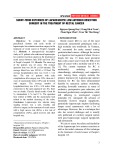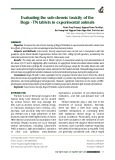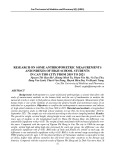
Can Tho Journal of Medicine and Pharmacy 10(7) (2024)
47
RESULTS OF GLYCEMIC CONTROL
AMONG SEVERE STROKE PATIENTS
Nguyen Thi Ngoc Han1*, Pham Thu Thuy1, Doan Thi Kim Chau1
Ngo Duc Loc1, Nguyen Tran Khanh Duy1, Ha Tan Duc2
1Can Tho University of Medicine and Pharmacy
2Can Tho Central General Hospital
*Corresponding author: ntngochan@ctump.edu.vn
Received:05/07/2023
Reviewed:18/09/2023
Accepted:24/10/2023
ABSTRACT
Background: Hyperglycemia is a relatively common condition in stroke patients, whether
they have diabetes or not, and it is associated with adverse outcomes. Achieving target blood glucose
levels has a partial impact on the results, but it is not the sole determinant. Objectives: We assessed
the result of glycemic control among severe stroke patients. Materials and methods: A prospective
study was conducted in the Stroke Department, Can Tho Central General Hospital, from June 2020
to April 2022, with 72 severe stroke patients monitored the capillary blood glucose every 3 hours.
Nineteen patients who had persistent hyperglycemia were controlled with continuous intravenous
insulin. We determined the average blood glucose level for each patient, the time needed to reach
the glycemic target range, the frequency of hypoglycemia, and the glycemic variability from all
measured blood glucose concentration. R programming was used to analyze the data. Results: The
average age of patients was 65.1±16.1. The percentage of ischemic stroke, accounting for 55.6%,
was the highest, followed by cerebral hemorrhage at 34.7%, 1.4% of these patients was attributed
to cerebral venous thrombosis. In admission, the median Glasgow score was 8 (IQR: 7-9), and the
median modified Rankin score was 5 (IQR: 4-5). Enteral nutrition was the primary nutritional
therapy. Among 53 severe strokes without persistent hyperglycemia, blood glucose levels fluctuated
around the mean value of 143 mg/dL. In 19 patients with persistently elevated blood glucose
concentration, the mean blood glucose levels preinfusion and post-insulin infusion were
299±117mg/dL and 165±43.2mg/dL, respectively; time to glycemic target was 8.25 hours (95% CI:
3.50-14.75 hours), the minimum was 3 hours, and the longest was 189 hours; 5.3% of these patients
developed hypoglycemia, and 13.3% of persistent hyperglycemia patients did not obtain the target
range. Conclusions: Blood glucose levels fluctuate within the target range among patients with non-
hyperglycemia or non-persistent hyperglycemia. In patients with persistent hyperglycemia
controlled with intravenous insulin, the mean blood glucose levels were achieved close to the upper
limit of the glycemic target.
Keywords: hyperglycemia, insulin infusion, severe stroke.
I. INTRODUCTION
Stroke is ranked as one of the leading causes of death and disability worldwide, with a
substantial economic burden on treatment and post-stroke care [1]. According to the World Stroke
Organization Report 2022, one in four people over the age of 25 will have a stroke in their lifetime
[2]. In Vietnam, with a population of about 98.32 million people in 2021, the incidence was
estimated over 157 per 100.000 people [3]. Especially, the number of patients with severe cerebral
stroke requiring intensive care can be as high as 10-30%, depending on medical resources and
admission criteria in intensive care units in each country [4].
Hyperglycemia is common in diabetic and nondiabetic patients during the acute phase of
stroke [5], [6]. The vivo studies have shown that hyperglycemia enhances the breakdown of the






![Study on toxicities of 10β-[(2'β-hydroxy-3'- imidazol) propyl] deoxo-artemisinin (32) in reproductive and developmental progresses of mice](https://cdn.tailieu.vn/images/document/thumbnail/2025/20250228/viinuzuka/135x160/8021740737116.jpg)

































